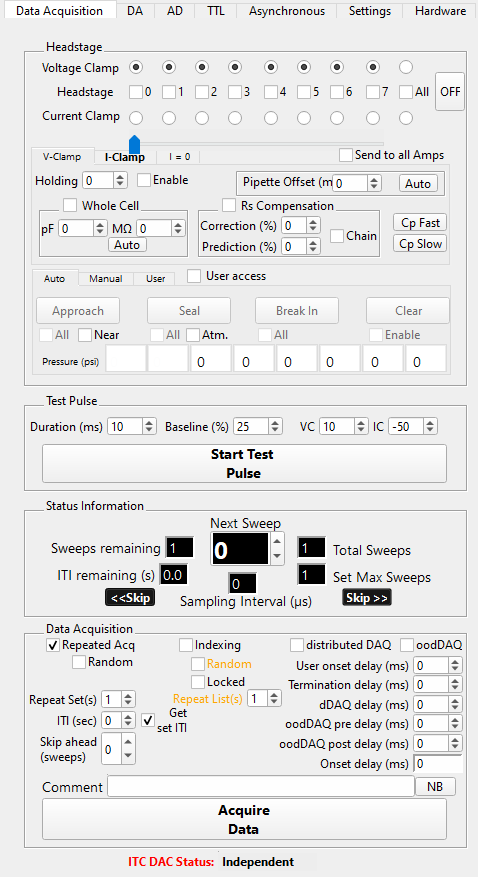Da_Ephys¶
The DA_Epys panel centralizes control of data acquisition, including multiple hardware components necessary for performing electrophysiology experiments, such as the DAC, amplifier, and pressure regulators.

Main data acquisition panel¶
The main data acquisition panel centralizes and simplifies manual control of the amplifier, pressure control, test-pulse, and data acquisition for up to 8 headstages. For headstage dependent controls, the slider determines which headstage to apply user input.
Distributed DAQ (dDAQ)¶
dDAQ simplifies the acquisition of synaptic responses during paired recordings. In paired recordings, each cell can be pre- and postsynaptic. dDAQ distributes the stimulus set sweep in time across headstages. Temporal distribution the stimulus set sweep ensures that the postsynaptic cell isn’t being stimulated simultaneously with the presynaptic cell, which would obscure any synaptic response(e.g., PSP, PSC). dDAQ delay inserts an acquisition time delay between the stimulus set sweeps on each headstage. dDAQ automatically adapts as headstages are enabled or disabled during data acquisition.
Optimized overlap distributed DAQ (oodDAQ)¶
oodDAQ simplifies and speeds the acquisition of synaptic responses during paired recordings. In paired recordings, each cell can be pre- and postsynaptic. oodDAQ distributes the non-zero epochs of the stimulus set sweep in time across headstages. Temporal distribution of non-zero regions of the stimulus set sweep ensures that the postsynaptic cell isn’t being stimulated simultaneously with the presynaptic cell, which would obscure any synaptic response(e.g., PSP, PSC). oodDAQ pre- and post-delay extend the region of non-overlap to include zero regions around the non-zero region. These delays ensure the synaptic response can complete before the cell is stimulated to elicit a (presynaptic) action potential. Pre- and post-delay are highly recommended when the stimulus set sweep contains pulse trains. To maintain optimal stimulus distribution, oodDAQ automatically adapts if headstages are enabled or disabled during data acquisition.